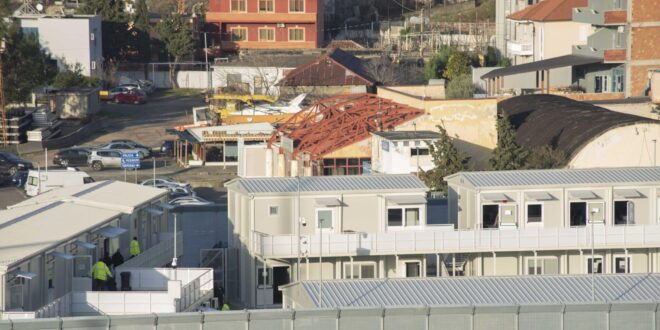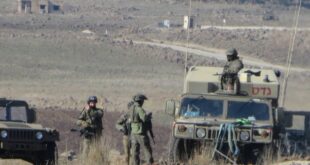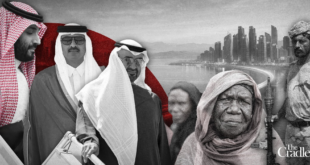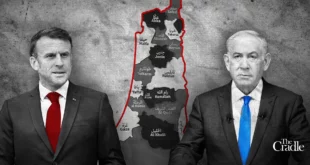As Nizam* sped toward Italy on a crowded migrant boat, he filmed what he believed was the final stretch of his harrowing journey.
The 21-year-old house painter from Bangladesh held up his phone, framing his face before panning to roughly 50 others packed onto the white fiberglass vessel. Behind him, a man covered his eyes with his hands, seemingly in tears, while another, smiling, patted him on the back. The boat’s stern sat low as it cut through the twinkling Mediterranean.
Nizam would later post the clip on TikTok. A voiceover in Urdu can be heard saying: “Let’s go, our time has come. Don’t worry, we’ll be back together.”
Back home in a small village in Bangladesh’s Madaripur district, Nizam’s parents anxiously awaited news of their son.
His mother and one of his three sisters had taught him to read, but instead of going to school, Nizam had worked to support the family. On social media, he crafted a playboy image, posting videos of himself in sunglasses, perched on borrowed superbikes, a stylishly cropped flop of hair completing the look. But his reality was far less glamorous. With his elderly father unable to work, Nizam was the only breadwinner in the household.
“Our family is very poor,” he said. “I have to work.”
His desperate parents scraped together money to pay a trafficker who was well known in their village. They sold a small piece of land and went into debt.
Smuggled first to India, then Sri Lanka, Kuwait and Egypt, Nizam eventually arrived in Libya – first Benghazi, then the capital, Tripoli – where he fell into the clutches of the mafia. They seized his passport and imprisoned him for three days, filming as they tortured him. The videos were sent to his family alongside ransom demands.
Nizam was released after his parents paid part of the ransom.
“One night, they took me to a beach and forced me onto a boat,” Nizam recalled. The boat was bound for Italy, setting off from the Libyan port of Zuwara.
Nizam couldn’t swim and the vessel was so overcrowded he was certain he would die. Yet as the boat approached the Italian island of Lampedusa, one of Europe’s biggest landing points for asylum seekers, he clung to the hope that the worst was behind him.
He was wrong. More than 300 migrants were intercepted in late January by Italian authorities after departing from ports in Libya. Nizam was among them. He was transferred to a naval vessel stationed 20 miles off Lampedusa and screened for health conditions, age and nationality.
Forty-nine, including Nizam, were told they would be sent to migrant camps in Albania, under an outsourced, fast-track asylum processing arrangement between Rome and Tirana that swung into action late last year.
The scheme has been hailed by the European Commission – the executive arm of the European Union – as a potential model for the bloc in its effort to curb the numbers of refugees and migrants reaching its borders; critics say it is inhumane and flies in the face of international humanitarian law.
In Albania, Nizam and the other migrants spent an exhausting week being shuttled between two centres – in the port town of Shengjin and nearby Gjader – while they completed paperwork and underwent health checks, interviews and court hearings. Six who were found to be minors or deemed vulnerable were relocated to Italy. The remaining 43, Nizam included, filed asylum requests, which were swiftly rejected, clearing the way for their deportation.
Before that could happen, however, an Italian court intervened, ruling – for the third time – that the migrants could not be legally held in Albania. Together with the other migrants, Nizam has since been transported to a reception centre in Bari, Italy, where he awaits the outcome of his asylum appeal.
Italy’s right-wing prime minister, Giorgia Meloni, has vowed she will not be stopped by the courts; in September, she received a visit from British Prime Minister Keir Starmer, interested in hearing about the initiative after declaring a previous British plan to send migrants to Rwanda “dead and buried”. The following month, European Commission President Ursula von der Leyen, who has expressed support for repatriation hubs outside the bloc, urged member states to draw “lessons from the Italy-Albania protocol”.
Her plan looked especially timely when, on March 11, the European Commission unveiled a proposed legal framework allowing EU member states to set up repatriation centres outside the bloc. Conceived under pressure from anti-migration governments, the regulation will replace an existing 2008 directive to permit “return hubs” in third countries that uphold “international human rights standards and principles,” according to a draft document.
The proposed hubs would be for failed asylum seekers alone. This differs from the Italy-Albania deal, which foresees the offshore processing of asylum requests .
For the likes of Nizam, however, critics say the Italian scheme is needlessly prolonging an already traumatic journey.
“It is a propaganda experiment predicated on making people suffer,” said Rachele Scarpa, an MP with Italy’s opposition Democratic Party. “Unfortunate people’s essential rights are being reduced to a minimum.”
Silvia Calderoni, a lawyer representing Nizam and three other migrants transferred to the camps with him, declined interview requests, stating that her four clients needed psychological support before speaking publicly. This account of Nizam’s ordeal is based on court documents and interview transcripts obtained by BIRN.
Court battles
Unveiled by Meloni and her Albanian counterpart, Edi Rama, in 2023, the offshore processing scheme foresees the incarceration of adult males from so-called ‘safe countries’, picked up in international waters without identification papers. They face an accelerated, 28-day asylum process before almost certain repatriation.
Italy initially budgeted 653 million euros for the scheme over five years, but actual costs have already soared, with expenses for building the two camps rising more than two thirds last year, from an estimated 39.2 million euros to 65 million euros.
Meloni originally projected the camps in Albania would process 36,000 migrants per year, but the scheme immediately hit a snag.
On October 4, the EU’s Court of Justice, CJEU, ruled that a “safe” designation must apply to a country’s entire territory, a ruling that a court in Rome subsequently cited when it refused to approve the detention of a first group of migrants transferred to Albania later that month.
The migrants were sent back to Italy for regular asylum processing, leaving Meloni’s government fuming at what it claimed was judicial overreach. In response, her government attempted to strengthen its legal position by approving a new list of 19 ‘safe countries’ by decree, thus enshrining it in law.
Meloni’s strategy failed: when a second group of migrants was sent to Albania in November, the Rome court suspended the decision and referred the case to the CJEU.
The Italian judges had asked the CJEU in late October to clarify whether exceptions to the safe country definition could be made for specific categories of people. A hearing was held on February 25 and the court is expected to issue its ruling in the spring.
Not waiting for the ruling, Meloni pressed ahead with the transfers, brandishing a ruling from Italy’s highest court in December which she said meant the government – not the courts – determines safe countries. While the government’s right to determine safe countries had never been in doubt, the court stressed that judges can assess the validity of the law on a case by case basis.
On January 24, the Italian military vessel Cassiopea took position around twenty miles off the coast of Lampedusa as migrant departures from Libya surged during favourable weather. The Italian coastguard and finance police intercepted eight boats approaching Lampedusa, transferring many of those on board to the Cassiopea. The migrants were screened on board for eligibility for transfer to Albania.
According to the Italian interior ministry, 53 produced IDs and were taken to Italy for regular asylum processing; another 49 – six from Egypt, one from Ivory Coast, one from Gambia and the rest from Bangladesh – were cleared for transfer to Albania.
‘Exhausted and incredulous’
Confusion about their destination led to chaos on the boat, according to a group of Italian opposition MPs and human rights experts who inspected the Albanian camps. During the inspection, the group recounted, an Egyptian migrant said that he and his compatriots had refused food on the boat.
“They didn’t know they were going to Albania,” said Cipriana Contu, an Italian lawyer who took part in the inspection.
“It was a moment of desolation, very emotionally taxing. He said when they learned they would be sent to Albania, they went on hunger strike, and some burst into tears.”
Papia Aktar, a Rome-based Bengali interpreter and legal adviser also present, said: “They were exhausted and incredulous.”
An interior ministry official with knowledge of the operation, who spoke on condition of anonymity, said, however: “We have had no indication of refusal of food.”
The Cassiopea docked in Shengjin at around 7:30 a.m. on January 28.
A BIRN reporter witnessed the migrants disembark in groups of nine or ten, feet heavy with fatigue as they filed past a cordon of police officers, doctors and aid workers. They wore sandals and identical blue jumpers; some were wrapped in shawls and warm hats against the biting winter air. Clutching small plastic bags of personal belongings, they disappeared into the camp set up at the port.
Ded Bukaqeja was also watching. The owner of a telecom company providing internet at the camps, Bukaqeja was among the first wave of Albanian migrants who fled to Italy by ship in the 1990s following the fall of Albania’s Communist regime.
“They were exhausted, deeply shaken. It was heartbreaking,” he said of the arrivals in Shengjin. “When I saw them suffering like that, it brought everything back – exactly how we were when we left. No one leaves their home country for fun.”
In the grey prefabricated containers of Shengjin’s fenced reception centre, the migrants were checked for infectious diseases, given clothes, fed and briefed on the asylum process.
During medical and psychological checks, four migrants were discovered to be minors. Another was identified as ‘vulnerable’. All five were relocated to Italy for the regular asylum procedure, which can take years to complete.
The interior ministry official BIRN spoke to said the four minors had originally claimed they were adults during checks on the boat, only to revise their statements after arriving in Albania.
But Scarpa, the opposition MP who led the inspection, said they would likely have declared their ages earlier had there been more time to explain their rights to them.
Fast track glitches
The remaining migrants in Shengjin were issued detention orders, which required approval by Italian courts within 48 hours, then transported to Gjader, a larger centre some 20 kilometres inland, surrounded by walls five metres high.
Phone access was restricted.
“Some of them haven’t communicated for days, and family members might believe they are dead,” said an Albanian legal assistant for Medihospes, an Italian organisation offering services including healthcare, psychological support and legal aid within reception centres across the country. Medihospes was selected last year by the Italian government to provide services within the Albanian camps.
“When they make a call and hear a ‘hello’ from their loved ones on the other end, they break down in tears,” the legal assistant said.
The authorities in Italy conducted asylum interviews with them via video link; the transcripts indicate that lawyers for the migrants were not present – standard practice for such interviews, Calderoni and the ministry source said – but were provided with an interpreter.
Nizam was not the only one from Madaripur. The others included Malik, 27, and Rohan, 22.
According to transcripts of their interviews with Italian officials, Malik had previously been a university student who had to take on farmwork to support his diabetic mother when his father died; Rohan told interviewers he had left for Europe in the hope of providing a better life for his wife and unborn daughter. In Libya, he said he was arrested by police and sold to the mafia; he spent two years in prison, where he was beaten and suffered a fractured shoulder.
“I never studied, but my daughter must study,” he said during the interview with Italian officials, who spoke with the migrants in Albania via video link, according to the transcript.
Malik told interviewers that creditors determined to force him to pay back soaring loans had attacked his sister in Bangladesh with a stick, breaking her nose. During 11 months in a Libyan prison, he said the people holding him had ripped out his fingernails and burned him with cigarette butts.
“I have marks all over my body from the violence I suffered in Libya,” he said. “They did not give me food, drink or allow me to wash. They treated me in pitiful conditions.”
Malik pleaded not to be returned to Bangladesh. “I would just like to have the opportunity to come to Italy and stay to work,” he said. “I would like you to carefully consider my request.”
Nizam, the house painter, made a similar appeal. “I have a request to the Italian state, to send me to Italy so I can find a job,” he said. “With that job I can support my family and have a better future.”
During the interviews, a second ‘vulnerable’ case was detected and relocated to Italy. “We identified a vulnerable person because he was limping. I later learned he had burn marks,” explained a second legal assistant for Medihospes, a former public official in Lezhe who spoke on condition of anonymity.
All other asylum requests were rejected the following day, January 29. The migrants – including Nizam, Malik and Rohan – were given seven days to appeal.
Francesco Ferri, a migration expert at ActionAid who was also present during the inspection, criticised the pace of the checks, arguing they were too quick for any psychological trauma to be detected.
Contu said the migrants she met during the visit seemed confused over legal procedures and that the migrants should have been given more time to process their trauma.
“Somebody who comes from an experience of persecution needs time, both to digest [that] he has undergone persecution and torture, and to express himself,” she said. “The risk is either they do not say everything, or they come across as contradictory.”
The interior ministry official disputed this, saying that the migrants were provided with free access to legal support, informed in detail about their legal rights and received a 20-minute briefing followed by individual consultations lasting two to three hours.
The Medihospes legal assistant who had seen the burn marks on the second migrant deemed vulnerable agreed: “We try to help the migrants and want their asylum applications to be successful.”
A legal showdown
Under arrangements for the scheme, Italian authorities must secure approval from Italy’s courts for the detention of migrants, with judges asked to rule within 48 hours.
In December, in an effort to break the legal impasse, Meloni shifted jurisdiction for the detention rulings to the city’s appeals court, which she believed would be more sympathetic. The change was quietly introduced through an article inserted into an unrelated law on work visa quotas passed shortly before Christmas.
The court director appointed six judges to oversee the detention cases, including four who had already ruled on the two previous groups of migrants sent to Albania, fueling speculation that the detention requests would once again be refused.
The detention hearings took place on January 31 behind closed doors in half a dozen office-style ‘courtrooms’ of a Rome court.
A BIRN reporter glimpsed judges preparing to question migrants via video link with interpreters through the doors as they swung open and shut.
Lawyers sitting in the corridors anxiously reviewed documents while awaiting their turn. Journalists were barred from entering the courtrooms.
For some of the migrants, the uncertainty had clearly taken a toll.
“The detainee cried throughout the hearing,” read the minutes from Nizam’s hearing.
Calderoni, his lawyer, criticised the speed of the process, having been assigned cases less than 24 hours before the hearings were scheduled to take place. This left her with little time to prepare or speak with the migrants. “We are forced to work in the dark,” she said.
In an order issued on the evening of January 31, the court declined to approve all 43 detention orders and referred the decision to the CJEU.
In a further blow to Meloni, the migrants were to be relocated to Italy.
A video shot by an Albanian port official, shared with BIRN, shows the migrants carrying large black bags as they walk in single file up a metal ramp onto an Italian coast guard patrol boat. Unlike when they arrived, they wore warm jackets and proper shoes.
The migrants arrived in Bari on the evening of February 1. As the boat glided into the port, they could be seen peering through the portholes, some smiling as they took in the scene. Protesters against the scheme gathered nearby shouted and held a banner that read ‘Welcome.’ After disembarking, the migrants were loaded onto a bus and transferred to a reception centre on the city’s outskirts.
Lawyers scrambled to appeal against their clients’ asylum rejections. Contu confirmed that all had appealed before the seven-day deadline.
Meanwhile, in Albania, the Shengjin and Gjader camps for now stand empty. A core of staff remains, spending long hours in the prefabricated cabins or sipping coffee at the few bars that kept working through the winter along Shengjin’s seafront.
For Nizam, Malik and Rohan, their days of confinement are now over. In Italy’s reception centres, residents are free to leave during the day. Calderoni said her clients were “recovering” and that they could soon begin work, with court rulings on their asylum appeals expected this year.
Nizam has returned to social media, posting photos and videos of himself by the Adriatic Sea, or taking in grand local landmarks such as Bari’s art nouveau Teatro Margherita.
One photo shows him standing in front of a cafe, framed by pine trees, looking effortlessly stylish in his sunglasses and loose shirt.
 Eurasia Press & News
Eurasia Press & News



